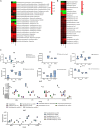The Combination of Lead and Bacillus coagulans R11 Increased the Concentration of Alpha-Solanine in the Cecum of Laying Hens and the Pathogens Abundance Decreased
- PMID: 33193232
- PMCID: PMC7609407
- DOI: 10.3389/fmicb.2020.585197
The Combination of Lead and Bacillus coagulans R11 Increased the Concentration of Alpha-Solanine in the Cecum of Laying Hens and the Pathogens Abundance Decreased
Abstract
Alpha-solanine is an alkaloid that can inhibit the growth of pathogens and cancer cells, the present study proved that feeding with Bacillus coagulans R11 increases the concentration of alpha-solanine in the cecum of laying hens, which also decreases the abundance of potential pathogens. In addition, the bacteria genera, metabolism pathways and its proteins involved in the biosynthesis of alpha-solanine in the cecum were also characterized. The results showed that B. coagulans R11 feeding could increase the concentration of alpha-solanine, even with lead exposure. Mevalonic acid and MEP/DOXP pathways were both participated in the biosynthesis of alpha-solanine; at the same time, the gut metabolites (S)-2-amino-6-oxohexanoate, N2-succinyl-L-ornithine and the bacteria proteins atoB, ispH were shown to be crucial role in the biosynthesis of alpha-solanine in the gut. The genera Faecalibacterium sp. An77 and Faecalibacterium sp. An58 2 were important in the biosynthesis of alpha-solanine, which provided the key proteins atoB and ispH. In addition, alpha-solanine could decrease the abundance of Prevotella sp. 109 and Prevotella marshii. In conclusion, alpha-solanine could be biosynthesized by cecal microorganisms with the stimulation of B. coagulans R11 in the intestine of laying hens, in addition, alpha-solanine was the main compound which also decreased the abundance of gut potential.
Keywords: B. coagulans R11; laying hens; lead; pathogens; α-solanine.
Copyright © 2020 Xing, Chen, Chen, Wu, Huang, Zhang, Mi and Liao.
Figures






Similar articles
-
Bacillus coagulans R11 consumption influenced the abundances of cecum antibiotic resistance genes in lead-exposed laying hens.Environ Pollut. 2021 Apr 1;274:116562. doi: 10.1016/j.envpol.2021.116562. Epub 2021 Jan 27. Environ Pollut. 2021. PMID: 33545525
-
Metabolic activity of Bacillus coagulans R11 and the health benefits of and potential pathogen inhibition by this species in the intestines of laying hens under lead exposure.Sci Total Environ. 2020 Mar 20;709:134507. doi: 10.1016/j.scitotenv.2019.134507. Epub 2019 Dec 16. Sci Total Environ. 2020. PMID: 31881475
-
Bacillus coagulans R11 maintained intestinal villus health and decreased intestinal injury in lead-exposed mice by regulating the intestinal microbiota and influenced the function of faecal microRNAs.Environ Pollut. 2019 Dec;255(Pt 2):113139. doi: 10.1016/j.envpol.2019.113139. Epub 2019 Sep 13. Environ Pollut. 2019. PMID: 31563774
-
Probiotic Effects of Bacillus licheniformis DSM5749 on Growth Performance and Intestinal Microecological Balance of Laying Hens.Front Nutr. 2022 Apr 27;9:868093. doi: 10.3389/fnut.2022.868093. eCollection 2022. Front Nutr. 2022. PMID: 35571886 Free PMC article.
-
Alpha Solanine: A Novel Natural Bioactive Molecule with Anticancer Effects in Multiple Human Malignancies.Nutr Cancer. 2021;73(9):1541-1552. doi: 10.1080/01635581.2020.1803932. Epub 2020 Aug 7. Nutr Cancer. 2021. PMID: 32762370 Review.
Cited by
-
Alterations in Intestinal Antioxidant and Immune Function and Cecal Microbiota of Laying Hens Fed on Coated Sodium Butyrate Supplemented Diets.Animals (Basel). 2022 Feb 22;12(5):545. doi: 10.3390/ani12050545. Animals (Basel). 2022. PMID: 35268114 Free PMC article.
References
-
- Cheng D. K. (2017). Primary and secondary metabolites. Ethnobotany 111:1589.
LinkOut - more resources
Full Text Sources

